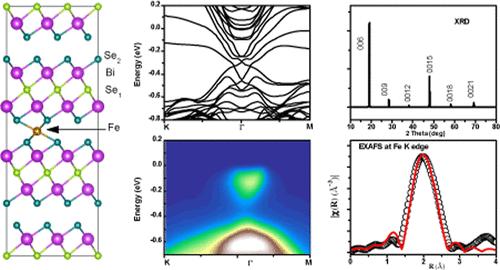A Combined Theoretical and Experimental Investigation on an Fe-Doped Bi2Se3 Topological Insulator
IF 3.2
3区 化学
Q2 CHEMISTRY, PHYSICAL
引用次数: 0
Abstract
Research on magnetic ion doping in topological insulators (TIs) such as Bi2Se3 is rapidly advancing due to its technological potential and relevance to fundamental physics. In this study, a detailed investigation has been carried out on an Fe-doped Bi2Se3 system through ab initio density functional theory (DFT) calculation and X-ray absorption spectroscopy (XAS) and angle-resolved photoelectron spectroscopy (ARPES) measurements on Fe-doped Bi2Se3 single crystals. Formation energy calculations indicate that Fe preferentially occupies interstitial sites in the van der Waals gap, a finding supported by the XAS and ARPES measurements. The simulated electronic band structure reveals that interstitial Fe doping preserves the bandgap of pristine Bi2Se3, while substitutional doping at Bi sites reduces it. The presence of Se vacancies in the system, as obtained from DFT simulations, has also been corroborated by XAS measurements. Thus, the above combined theoretical and experimental investigations have offered significant insight into a transition metal-doped TI system, which is important for both technological applications and exploration of exotic fundamental physical phenomena.

掺铁Bi2Se3拓扑绝缘体的理论与实验结合研究
由于其技术潜力和与基础物理学的相关性,在Bi2Se3等拓扑绝缘体(TIs)中磁离子掺杂的研究正在迅速推进。在这项研究中,通过从头算密度泛函理论(DFT)计算和x射线吸收光谱(XAS)和角分辨光电子能谱(ARPES)测量对fe掺杂Bi2Se3体系进行了详细的研究。地层能量计算表明,铁优先占据范德华间隙中的间隙位置,这一发现得到了XAS和ARPES测量的支持。模拟的电子能带结构表明,间隙Fe掺杂保留了原始Bi2Se3的能带,而在Bi位上的取代掺杂使其减小。从DFT模拟中得到的系统中Se空位的存在也被XAS测量证实。因此,上述理论和实验相结合的研究为过渡金属掺杂TI体系提供了重要的见解,这对于技术应用和探索奇异的基本物理现象都具有重要意义。
本文章由计算机程序翻译,如有差异,请以英文原文为准。
求助全文
约1分钟内获得全文
求助全文
来源期刊

The Journal of Physical Chemistry C
化学-材料科学:综合
CiteScore
6.50
自引率
8.10%
发文量
2047
审稿时长
1.8 months
期刊介绍:
The Journal of Physical Chemistry A/B/C is devoted to reporting new and original experimental and theoretical basic research of interest to physical chemists, biophysical chemists, and chemical physicists.
 求助内容:
求助内容: 应助结果提醒方式:
应助结果提醒方式:


